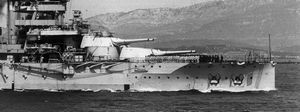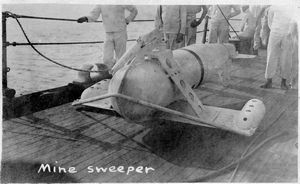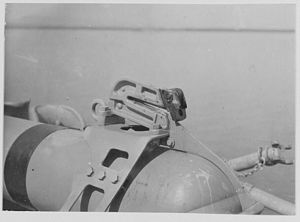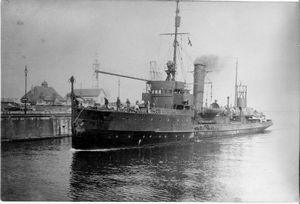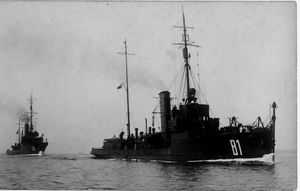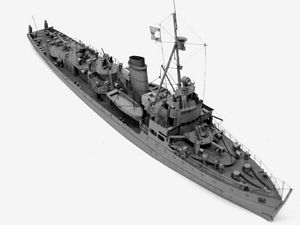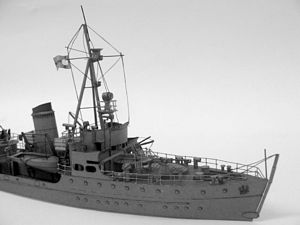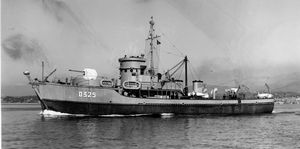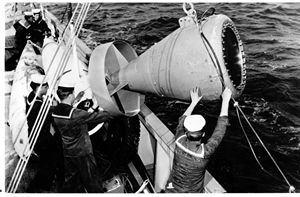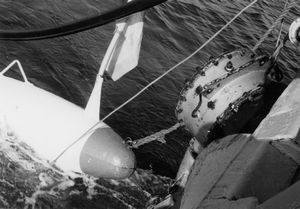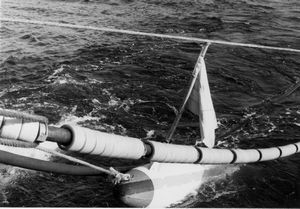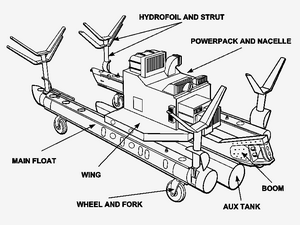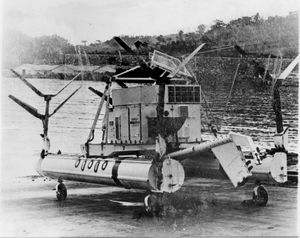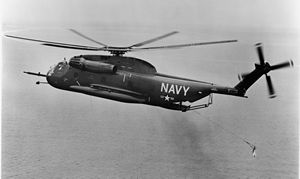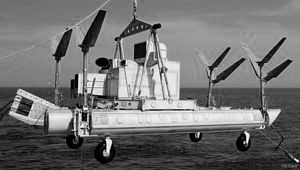| Mine warfare: Mines, Minelayers, Minesweepers |
| Part 1: Mines |
|
Catalogue number 81 Early mines The presentation case shows models of a variety of pre-World War One mines. Far left is a mine barrier, center to right are contact mines and far right is a coastal mine barrier, covered at high water. Verso: "Marine Militaire. No. 16 Different types of torpedoes, anchored or seabed mines" in black ink and from a wooden-boxed collection of 29 glass plate positives dated 25 January 1910 Credit: E. Mazo Paris 7.1cm x 7cm Glass plate positive |
 |
|
Catalogue number 27031 Spanish "torpedo" mine, 1898 Sea mines were initially called torpedoes after the fish of that name(torpedo ray) which can deliver a strong electric shock. This is a contact mine with metal arms that trigger the firing mechanism. The plate at the base of the mine turns in the water and slows down payout of the mooring line as the sinker drops to the seabed. Recto: “Spanish torpedo taken from Harbor of Santiago” Verso: "In modern warfare explosives are coming more and more into use. Streets and thoroughfares as well as rivers, straits and harbors over which it is though the enemy may pass, are mined with deadly explosives sufficiently powerful to wreck the mightiest battleship or overwhelm a large land force. Torpedoes are usually made in forms similar to a cigar, so that they may be projected under the water, the sharp end going forward. As is well known, they can be arranged to explode by contact, a time fuse, or an electric wire. The sample death dealing instrument shown in this view provided with contact arms which when struck, thrust a spike into the interior as shown, causing explosion by percussion. Doubtless it was some such contrivance as one of those described above, which, on Feb. 15th, 1898, tore into shreds and sent to the bottom of Havana Harbor, our proud battleship "Maine" together with nearly her entire crew." Credit: B.L. Singley 15.3cm x 8.3cm Stereo gelatin silver print |
 Santiago mine copyright 1898 wb12 27031.jpg) |
|
Catalogue number 108028 Controlled mines, U.S.S. New Hampshire, Guantanamo Preparing American controlled mines on board the U.S.S. New Hampshire. Note how the gun barrel in the foreground is buffed up. Verso: "Mine drill on U.S.S. New Hampshire. At Guantanamo, Cuba" in black ink. Stamp box model of 1904 to 1918 13.7cm x 8.7cm Gelatin silver print |
 |
|
Catalogue number 44249 Rigging for a controlled minefield, U.S.S. Vermont, Guantanamo, 1912 The explosive charge is fixed and then the two hemispheres are bolted together. Verso: "Rigging the mines and aired bedding. U.S.S. Vermont. These are the boxes inwhich the explosive mines powders are placed. When anchored with their round balls a little below the surface of the water they are a terrible destruction to the ships whose side touches them. Once a week, usually on Friday, the crew's hammocks are aired on the lines from reville in the morning till noon, hammock inspection sometimes follows. Jan 1912 Guantanamo Cuba" in black ink 12.8cm x 7.7cm Gelatin silver print |
 |
|
Catalogue number 44248 Loading mines on a ship's boat, U.S.S. Vermont, Guantanamo, 1912 The mines and sinkers will be taken out to the minefield, note the lengths of electric wire. Verso: "Ready for placing the mines U.S.S. Vermont. A sailing launch is in front with a manned dinghy behind. A framework is placed on the launch and six mines are ready for lowering. The mushroom anchors that hold them down are below the water. The cylindrical boxes at the water's edge are the battery boxes. The uncharged mine globes are on the raft. In this drill the little floats are used as markers to find the mines again. Of course these are only used in drill. Jan 1912 Guantanamo Bay Cuba" in black ink 7.6cm x 12.8cm Gelatin silver print |
 |
|
Catalogue number 122071 German mine of the type laid by submarine These American sailors stand by a German mine laid by a submarine. The mine is in a four-post frame to protect the horns (removed in this photograph) whilst the mine was held in the submarine mine tube. The British designation was "Type II", 322 kg and a explosive charge of 131kg wet guncotton. 7.5cm x 12.5cm Gelatin silver print |
 |
|
Catalogue number 122043 Mine from German minelaying submarine In this photograph of a submarine-laid mine, two of the frames are folded back, the Herz horns are still in place and we can see the hydrostatic depth gear in the lower part of the support. Recto: "Military Museum. German sea mine brought up by the Trouville in the North Sea, 21st May 1918" in French 9.1cm x 12.6cm Printed image |
 |
|
Catalogue number 135070 British bottom influence mines from World War 1 The Sinker mk IM was the world's first magnetic mine and was in use from July 1918. A minefield was laid off the Belgian coast but the mines performed badly with premature explosions as well as detonations shortly after being laid. Recto: "The ruins of Zeebrugge 1914-18 English submarine mines" 13.6cm x 8.5cm Printed image |
 |
|
Catalogue number 70082 Stock of Spanish moored mines Spanish mines of the Spanish Society for Naval Construction (S.E. de C.N.), they may be controlled mines as no horns are evident. British shipbuilders were predominantely present in the S.E. de C.N. at the beginning of the 20th century with Vickers taking 40% of contracts. Verso: "S.E. de C.N. (Sociedad Espanola de Construccion Naval), Ferrol. A group of underwater mines." Credit: Hauser y Menet - Madrid 14.1cm x 9.3cm Printed image |
 |
|
Catalogue number 92089 British mines on a fast minelayer Over 60 contact mines can be seen on the rails of this World War Two Royal Navy fast minelayer. Verso: "Protecting the English coast. British minelayers lay minefields along the English coast and in the North Sea to protect from enemy attack. These mines are being prepared to be released. 2.1.40" in French 17.1cm x 12.8cm Gelatin silver print |
 |
|
Catalogue number 96058 A mine goes over the stern ramp A standard British World War Two mine going off the ramp. Verso: "To defend the English coast. To protect the English coast from the enemy, British minelayers have laid minefields all around the coast. Releasing a mine in the North Sea, photographed on board a minelayer. 1.2.40" in French 18.3cm x 11.7cm Gelatin silver print |
 |
|
Catalogue number 29010 Russian mine opened up on deck, S.M.S. Ausburg S.M.S. Augsburg laid a minefield off the Russian port of Libau in the Baltic Sea at the beginning of World War One. However, it is said that the minefield was poorly marked and was a hindrance to German naval operations in the area. The two mines shown here are Russian M1912 inertial mines. We can see the hydrostatic gripping device for locking the mooring rope on the deck left and the inertia pistol, mooring rope and drum to the right. 13.9cm x 9cm Gelatin silver print |
 |
|
Catalogue number 35169 Italian "J' type mines - spherical, no top but a bottom cover plate, two brackets on lower hemisphere - on a German warship. "Rabotti you will be slaughtered". Who was Rabotti? 11cm x 7.8cm Gelatin silver print |
 |
|
Catalogue number 137091 A lay of mines on Eugenio di Savoia, 1941 The crew prepare to push a lay of mines over the stern of the Italian cruiser Eugenio di Savoia, she laid a large minefield off the coast of Tripoli in 1941. Verso: "Eugenio di Savoie foto 4/1941" in light pencil 14.3cm x 8.9cm Gelatin silver print |
 |
|
Catalogue number 110016 Fairey Barracuda with bottom mines This aircraft, RK 328, was operational in May 1945 and went on to the Torpedo Development Unit at Gosport, June 1945. This photograph shows the Barracuda loaded with aircraft-layed ground mines. Verso: "Barracuda II with one Mk VII and two Mk VIII mines 23 Jul 1945" in black ink Credit: Temple Press Ltd. 20.7cm x 15.1cm Gelatin silver print |
 |
|
Catalogue number 110017 Fairey Barracuda with bottom mines Sturtivant states that in September 1945, this aircraft was used at the Aeroplane and Armament Experimental Establishment (A&AEE) for handling trial with 370lb and 570lb "SCI" (?). These mines were also layed by motor launches, being smaller and lighter than convention ground mines. Initially, the firing mechanism was magnetic then by combinations of magnetic, acoustic and pressure Verso: "Barracuda II fitted with 1 x Mk VII mine 23 Jul 1945" in black ink Credit: Temple Press Ltd. 20.7cm x 15.8cm Gelatin silver print |
 |
| Part 2: Minelayers |
|
Catalogue number 13031 French paddle minelayer Guepe The paddle minelayer Guepe was originally a tender named Lloyd (built by Nusck & Co, Gabrow 1914, 640 tonnes) for the Norddeutscher Lloyd company running out of Cherbourg to take passengers, luggage and mail to the transatlantic liners before starting the Atlantic crossing. She was seized and renamed Guepe for use as a patrol ship and then as a minelayer with the study group for mine warfare. The quarter deck aft of the paddles was taken up with a system of rails from which mines were pushed over the stern. Verso: "René Jacques's ship in the Mediterranean" in French and in black ink Credit: Emery 12.8cm x 7.8cm Gelatin silver print |
 |
|
Catalogue number 48071 German minelayer S.M.S. Pelikan The Pelikan was commissioned in 1891 taking on various minor functions before being converted to a minelayer in 1895. From the start of the First World War, Pelikan laid contact and anti-submarine mines in the German Bight, she could carry 400 mines. She was broken up in 1921. In these photographs, we can see forward and to starboard of the bridge, one of the four 15.5 pdr guns. 13.7cm x 8.6cm Matt gelatin silver print |
 |
 |
|
Catalogue number 40278 German minelayer S.M.S. Nautilus An interesting ship, commissioned in 1906 and could act as an ice-breaker (rounded bow), a boom charger as well as a minelayer carrying 400 mines (From Jane's 1914). It looks like mines were pushed off a rail that projected over the stern of the ship, see structure beyond the stern flagstaff. 14.4cm x 8.2cm Recent gelatin silver print |
 |
|
Catalogue number 110053 First World War German F-boats F-boats are often described as minesweepers but they also acted as minelayers carrying ground and contact mines. In this photograph, we can see contact mines on F27 and ground mines on the two boats in the foreground. Light vessels with a shallow draft made them well-adapted to minelaying in the coastal waters off the German coast. 13.8cm x 8.9cm Gelatin silver print |
 |
|
Catalogue number 110051 F-boats with ground mines, 1915 Part of an F-boat flotilla with at least two boats with mines on board (far right). When examing the quarter deck of these boats, there is no obvious minesweeping gear. Recto: "F-boats of a fast minesweeping flotilla" in German Verso: Franked Wilhelmshaven 1915 Credit: Krüger 13.8cm x 9cm Gelatin silver print |
 |
|
Catalogue number First World War German torpedo boat with mines This German torpedo boat has rails port and starboard loaded with contact mines. 13cm x 8.4cm Gelatin silver print |
 |
|
Catalogue number 44060 First World War German torpedo boat laying mines E-mines being prepared for laying, note the cylindrical shape as opposed to the spherical sea mines. 11cm x 8.3cm Matt gelatin silver print |
 |
|
Catalogue number 37152 R-boat with mines, Ostend R-boats played a similar role to the F-boats of the First World War. They are described as minesweepers but, as for the R-boats, there is no obvious minesweeping gear visable in this photograph. Verso: "The fight in the West. Sea mines seized in the harbour at Ostend.". From the collection "The fight in the West" propaganda series Credit: Raumbild-Verlag Otto Schonstein, Munchen (Editor's note: Schonstein specialised in producing stereo-images, notably as propaganda for the Nazi party) 11.2cm x 4.8cm Stereo gelatin silver print |
 |
|
Catalogue number 70022 French ship Pluton, 1913 The Pluton and her sister ship Cerbere were the first French Navy warships built as minelayers, capacity 120 mines and commissioned in 1914. Note the stern doors and the stern 100mm gun. Recto: "Pluton minelayer 1913 " Credit: Bar 13.1cm x 8cm Gelatin silver print |
 |
|
Catalogue number 138024 French ship Pluton, launch Pluton goes down the slipway at launching in Le Havre, 1913 Recto: "Launch of the minelayer "Pluton" after launching" in French and in fine black ink 13.1cm x 8cm Gelatin silver print |
 |
|
Catalogue number 43219 Pluton and Cerbere were a successful straightforward design from the Normand shipyard, Le Havre. Here we can see the foredeck 100mm gun. Recto: "Pluton minelayer 1913-21" Credit: Bar 13.5m x 8.2cm Gelatin silver print |
 |
|
Catalogue number 46187 Cerbere, sister ship to Pluton Here Cerbere has only the forward 75mm gun. Credit: Bar 13.4cm x 8cm Gelatin silver print |
 |
|
Catalogue number 01041 H.M.S. Minerva, ex-M33 coastal monitor H.M.S. Minerva (ex-M33, launched 1915) was one of four ex-coastal monitors that were converted to minelayers in the early 20s. They could carry 52 "H" type or 15 "L" type mines on rails on the open deck. In this photograph, we can see an unusual chute going from the top of the deckhouse over the quarter deck.- Credit: Wright and Logan/Royal Naval Museum 13.5cm x 8.4cm Gelatin silver print |
 |
|
Catalogue number 36264 Melpomene, ex-M31 coastal monitor This view of H.M.S. Melpomene (ex-M31, coastal monitor) shows four rounded, cylindrical mines on the rails. 14cm x 8.7cm Gelatin silver print |
 |
|
Catalogue number 01041 H.M.S. Medea, ex-M22 coastal monitor, 1930 H.M.S. Medea was the lead ship of the four Medea-class minelayers and was built by Raylton Dixon. She looks different to the other ships of the class with a shorter quarterdeck, hefty derricks to lift mines and a wooden hut on the deckhouse. She became a minelaying training ship in 1925. 16cm x 10.6cm Gelatin silver print |
 |
|
Catalogue number 135056 H.M.S. M6, M-class controlled minelayer So far, we have been describing ships that lay mines which detonate on contact or with the passage of a ship. A controlled minefield forms a barrage of electrically-connected mines that can be fired by an operator at an onshore location. During both World Wars, controlled minefields were associated with anti-submarine/anti-ship indicator loops. Passage of a steel vessel induced a current in the loop that could be detected onshore where a operator could trigger mines or automatically detonate the mines in that part of the field. H.M.S. M6 (later renamed MinerVI) has a cable guide over the bow and heavy lift derricks midships as well as a stern chute for laying the mines. Note the 20mm AA gun aft and two Lewis guns on the bridge wings. The bow shear is strengthen and strakes protect the hull as mines and cables are manoeuvred about the curved davits. Verso: "M6 " in pencil 20.3cm x 15.3cm Gelatin silver print |
 |
|
Catalogue number 01036 H.M.S. Linnet, controlled minelayer, 1938 H.M.S. Linnet was the lead ship of three Linnet-class purpose-built controlled minelayers launched in 1938. Here we can see the electric cables below the port davit, note the ship is not armed. Credit: Wright and Logan/Royal Naval Museum 13.3cm x 8.4cm Gelatin silver print |
 |
|
Catalogue number 03019 H.M.S. Redshank, controlled minelayer, 1953 Another Linnet-class controlled minelayer, we can see the foredeck chute to guide the electric cables over the bow. Credit: Wright and Logan/Royal Naval Museum 13.4cm x 8.3cm Gelatin silver print |
 |
|
Catalogue number 02018 H.M.S. Redstart, Controlled minelayer The third Linnet-class, H.M.S. Redstart is shown here with cables over the port side and a lay of mines on the quarterdeck. 13.5cm x 8.4cm Gelatin silver print |
 |
|
Catalogue number 63004 Coastal minelayer Plover A very smart ship with fine lines, H.M.S. Plover was a one-off but had a long and exceptional career from 1937 to 1969. During the war she is said to have laid over 15,000 mines. She is shown late in her career after a deckhouse had been built up on the deck. Credit: Skyfotos 23.5cm x 17.1cm Gelatin silver print |
 |
|
Catalogue number 138014 First British dedicated minelayer, H.M.S. Adventure Not only the first purpose-built minelayer of the Royal Navy, H.M.S. Adventure was a "first" on several other points. She was the first cruiser with a mixed propulsion with steam turbines for speed and diesel-electric propulsion for cruising, the funnel for diesel fumes was behind and close up to the second funnel. For the first time, a minelayer had a continuous internal deck with four rails (two port, two starboard) carrying the mines (280 large mines or 340 small mines). On completion in 1925, she was the first cruiser designed with a transom stern over which opened the chutes. However, the transom stern caused a vortex to arise in the ships' wake such that some mines were sucked back dangerously towards the stern. Note the canvas screens on the quarter deck. Recto: H.M.S. Adventure at Reykjavik 13cm x 8.3cm Gelatin silver print |
 |
|
Catalogue number 01004 H.M.S. Adventure, 1933 We can see here the rebuilt, rounded, cruiser stern and repositioning the minelaying doors to the side, a modification made to overcome the problem of mines being drawn back towards the transom stern when launched. Note the torpedo bulges. Credit: Wright and Logan/Royal Naval Museum 13.4cm x 8.3cm Gelatin silver print |
 |
|
Catalogue number 41309 Fast minelayer H.M.S. Apollo, 1952 Designed from the keel up, the four Abdiel-class cruiser minelayers could "Go like the Devil !". A cruiser hull could carry a large number of mines internally and the Abdiel-class ships reached remarquably high speeds - H.M.S. Manxman cruised at 44 kts, Latonia exceeded 49 kts. Their speed was an asset to avoid engagment with the enemy. They carried up to 150 mines on a chain conveyor for deployment over the stern. Credit: Wright and Logan/Royal Naval Museum 13.4cm x 8cm Gelatin silver print |
 |
|
Catalogue number 133096 H.M.S. Manxman, Abdiel-class fast minelayer, 1946 The Abdiel-class minelayers were kept very busy during the war and H.M.S. Manxman looks rather battered here in Malta, 1946. Note the closed stern hatches and two cranes port and starboard to bring the mines on board. The three two-turret guns were dual purpose and the anti-aircraft armament was extensive but speed was their best defence. We have read that these ships had more power per shaft than any other British warship except H.M.S. Hood! Verso: "Manxman 1946" in black ink Credit: Pavia 14.2cm x 9cm Gelatin silver print |
 |
|
Catalogue number 33127 H.M.S. Obdurate, destroyer modified for minelaying During both the First and the Second World War, destroyers were modified to be used as minelayers, their fast speed - to get in and to get out of the minelaying zone quickly- being a great advantage for this role although the mines were on deck and unprotected. H.M.S. Obdurate was one of four O-class 1942 destroyers modified to lay 60 mines, Y gun and both sets of torpedo tubes were removed for minelaying. Note the rails running along the deck from midships to the stern chutes. Credit: Skyfotos 24.4cm x 19.2cm Gelatin silver print |
 |
|
Catalogue number 88 F19 French minelayer Pluton The second Pluton was an unarmoured cruiser completed 1931. She could reach over 30 kts and carried 90 mines. She was lost after a mine explosion in Casablanca, 1939. Verso: " " Credit: Bar ***** Gelatin silver print |
 |
|
Catalogue number 88 F19 French minelayer Pluton, main deck plan This plan of the main deck shows the system of rails for carrying and laying the mines, note the turntables at the head of the dual rail system. Credit: Service Historique de la Defense |
 |
|
Catalogue number 21047 Castor The French minelayers Castor and Pollux were built as icebreakers for Russia before entering the White Russia navy. Seized by France in Bizerte and converted to minelayers 1927-29, Castor 368 mines, Pollux 236 mines. Note the vast mine chutes. Credit: Art-Photo 12.9cm x 7.9cm Gelatin silver print |
 |
|
Catalogue number 46188 Castor, 1929 Note the open gallery over the mine rails and the beginning of the rounded icebreaker bow. Credit: Bar 13.3cm x 8cm Gelatin silver print |
 |
|
Catalogue number 46189 Pollux Pollux was shorter than Castor, 64m compared to 75m. Note the 3.9-inch gun forward. Credit: Bar 13.3cm x 7.9cm Gelatin silver print |
 |
|
Catalogue number 114016 Pollux underway This view shows the quarter deck 3.9-inch gun, note the transom stern as opposed to the cruiser stern of Castor. The problem of the wake pulling mines back onto the transom stern (see above H.M.S. Adventure) was avoided by using the wide, fan-like mine chute with double rails. 13.1cm x 8.4cm Gelatin silver print |
 |
|
Catalogue number U.S.S. Terror, stern doors, 1945 This ship was, like H.M.S. Adventure, a one-off minelayer design for the U.S. Navy, commissioned 1942. With her relatively high speed (25 kts), she played numerous roles where speed and vast deck space were an advantage - delivering cargoes of mines and ammunition to operational theatres, depot ship for small vessels, casualty evacuation, logistic supplies and acting as flagship. Note the vast stern doors. Credit: Public domain, courteously provided by Navsource |
 |
|
Catalogue number U.S.S. Terror, aerial view, circa 1946 Nine hundred mines could be carried by U.S.S. Terror. Note the broad beam and the uncluttered quarter deck. Credit: Public domain, courteously provided by Navsource |
 |
|
Catalogue number 27032 U.S.S. Aroostook, circa 1920 Most minelaying in the U.S. Navy was done by existing vessels converted to that role. The Eastern Steam Ship Corporation purchased the ship from the Cramp Shipyard in 1912 and named her S.S. Bunker Hill before being acquired by the U.S. Navy and renamed U.S.S. Aroostook. She was converted to a minelayer in 1918 after an extensive rebuild. She played an important role in laying a total of 3,180 mines in the North Sea Mine Barrage of World War One. Verso: "Artisoock (sic) in San Diego" in pencil 13.6cm x 7.9cm Matt gelatin silver print |
 |
|
Catalogue number 127082 U.S.S. Shawmut, ex-U.S.S. Oglala This ship had several lives, first as the fast coastal freighter S.S. Massachusetts in 1907, then as a coastal passenger liner after a rebuild before being bought by the U.S. Navy for conversion to a minelayer in 1917 (named U.S.S. Massachusetts then renamed U.S.S. Shawmut). This photograph was taken in 1920 when the Shawmut was working as a floatplane tender in Guantanamo Bay although she was the U.S. Navy fleet's principal minelayer up to the early 1940s. Note the large stern doors, the ship assisted in the laying of the North Sea Mine Barrage. Recto: "USS Oglala" Credit: US Navy 11.1cm x 8.6cm Gelatin silver print |
 |
|
Catalogue number 121105 U.S.S. Aaron Ward, minelaying destroyer U.S. Navy destroyers were used as minelayers and several Sumners-class destroyers were converted during building to carry and lay mines. This photograph show U.S.S. Aaron Ward after being hit by - and surviving - a kamikaze attack in May 1945. Note the mine rails port and starboard running the length of the deck. Recto: "The minelayer Aaron Ward sustained 6 kamikaze suicide crashes in 59 minutes and lived" Credit: US Navy 9.1cm x 10.7cm Gelatin silver print |
 |
|
Catalogue number 110016 Fairey Barracuda with ground mines This Fairey Barracude RK328 is loaded up with mines and we can see one mk VII mine under the fuselage and two mk VIII small magnetic mines attached under the port wing. Note the aerial above the port wing. RK328 was a mark II Barracuda based at the Aeroplane and Armament Experimental Establishment in June 1945. Verso: "Barracuda II with one Mk VII and two Mk VIII mines. 23 JUL 1945" 20.7cm x 15cm Gelatin silver print |
 |
|
Catalogue number 138013 Handley Page Hampden A rather peculiar design of aircraft and cramped for the four crew but the Hampden played a most useful role as a minelayer. Shown here with an aerial mine Recto: "Hampden aircraft carry mines that they lay in enermy waters. This photo shows the ground crew of the Royal Air Force loading a mine into an aircraft" in French 12.7cm x 6.8cm Printed image |
 |
| Part 3: Minesweepers. |
|
Catalogue number 38090 Admiral Lord Beresford and minesweeping Whilst visiting the East coast ports during 1917, Beresford noted that Grimsby trawlers would be suitable for participating in minesweeping operations in war. The Grimsby trawler fleet, as for other ports, would be to a great extent inactive during war when the major fishing grounds would be dangerous. Furthermore, the crews of trawlers were more accustomed to handling the heavy otter boards and wire warps used in minesweeping compared to naval ratings although much less disciplined! After an initially notable career, his personality seemed to have changed for the worse (see, for example, the Fisher/Beresford disputes) and historians have suggested that he might have suffered a minor stroke at some time before 1907.(editor's note: reference made by Nicholas Lambert in Gordon, page 366, The Rules of the Game: Jutland and British naval command, 1966, London, John Murray). Citation from Volume 31, Encyclopaedia Britannica, 1922). 8.6cm x 13.7cm Printed image |
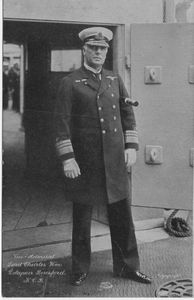 |
|
Catalogue number 6027 Grimsby trawler Ampulla showing otter boards Built 1913 Cook Welton and Gemmell, Beverley, UK, requisitioned as minesweeper September 1914 then auxiliary patrol vessel then minesweeper 1940, returned to fishing 1949, finally scraped 1962. Note the otter boards to starboard fore and aft hanging from the gallows. Credit: Grimsby Evening Telegraph 24.2cm x 19 cm Gelatin silver print |
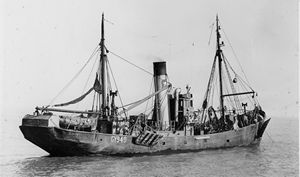 |
|
Catalogue number 03032 H.M.S. Dahlia, Acacia class Fleet Sweeping Sloop At the beginning of World War One and as part of an Emergency War Programme, the Royal Navy had built a large number of Acacia class fleet sweeping sloops, one of which was H.M.S. Dahlia. Shown here at Malta, the curved beam aft kept the wire sweep clear of the quarterdeck and a davit at the stern took the sweep wire. The bow had a triple hull to resist against damage by exploding mines. Recto: "" Credit: Wright and Logan 13.4cm x 8.3cm Gelatin silver print |
|
|
Catalogue number 55069 H.M.S. Camellia, Azalea class Fleet Sweeping Sloop The Azalea class of minesweeper sloops was a follow-on from the Acacia class, the two often referred to as the Flower class sloops. The two 4.7 inch guns and the A-frame for the sweep can clearly be seen. So can the washing hung out below the bridge! Verso: "Camellia 1915 minesweeper Azalea class type II Queenstown" in French and in light pencil 13.4cm x 8cm Gelatin silver print |
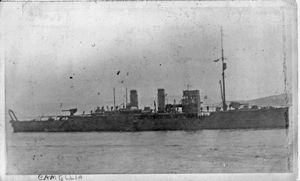 |
|
Catalogue number 96016 H.M.S. Melton, Ascot class Paddle Minesweeper Melton was originally fitted to carry seaplanes but never did so. Launched in 1916 as one of the Ascot class paddle minesweepers, she had a long career sweeping mines in both wars. A 6 pdr on the forecastle and a strong A-frame over the stern, in this photograph she shows her fine lines, paddleships were interesting as minesweepers due to the shallow draft. Recto: "H.M.S. "Melton" mine clearance service Devonport" Credit: Abrahams 12.5cm x 7.2cm Gelatin silver print |
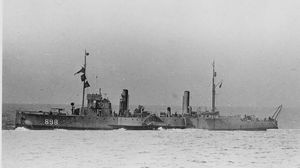 |
|
Catalogue number 138013 Ex-mercantile H.M.S. Monarchy ex-Monarch paddle minesweeper In early 1917, Monarch (built 1888) was requisitioned as a minesweeper and renamed HMS Monarchy to form part of the Bristol Channel Minesweeping Flotilla, minesweeping the Bristol Channel and Irish Sea until the flotilla disbanded in May 1919. A single otter board hangs from the A-frame, early minesweeping consisted of passing a wire between two minesweepers then going forward with the otter boards of each ship keeping the wire at the required depth. Wire cutters fixed at intervals along this wire, and even explosive charges, would cut the mooring wire of the swept mine. The 6 pdrs can be seen fore and aft. Credit: Imperial War Museum 16.5cm x 11cm Gelatin silver print |
 |
|
Catalogue number 141046 Ex-mercantile paddle minesweeper H.M.S. Devonia H.M.S. Devonia was another pre-World War One paddleship that saw action in both wars. She was built 1905, converted to minesweeper 1914, here she has exploded a mine close off the starboard quarter. After the First World War, Devonia went back into mercantile service working along the South coast and Bristol Channel before being reactivated as a minesweeper in 1939. She was busy during the Dunkirk evacuation but was eventually abandoned off the French coast after a heavy attack by enemy aircraft. 13.6cm x 8.6cm Gelatin silver print |
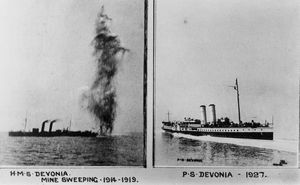 |
|
Catalogue number 29047 Ex-mercantile paddle minesweeper H.M.S. Duchess of Fife, 531 This is another good view of a paddle minesweeper, the Duchess of Fife was taken out of mercantile service and converted to a minesweeper in 1916. Credit: World Ship Photo Library 14cm x 9cm Modern reprint |
 |
|
Catalogue number 24014 Ex-mercantile H.M.S. Westward Ho, paddle minesweeper showing A-frame Another good view, this time of the stern of the paddle minesweeper Westward Ho. Built 1894, she was converted to a minesweeper in 1914 working in the River Tyne, went back to mercantile service as a pleasure steamer along the coast of South Devon. Converted to an auxiliary anti-aircraft vessel in 1942, other sources say she was an accommodation ship. Cocker in the book "Mine Warfare vessels of the Royal Navy" lists over 88 paddle steamers taken out of mercantile service and converted to minesweepers during the two wars with many of then built in the late 1800s! 14.2cm x 9.8cm Gelatin silver print |
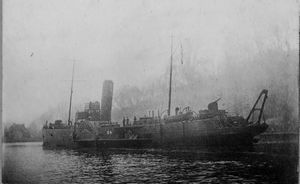 |
|
Catalogue number 135103 Royal Navy minesweepers at the end of World War One At the end of the war, the Royal Navy had a large fleet of minesweepers, most of which were specially built for the purpose. Here there are several Aberdare class minesweepers gathered in the port of Lervik, Norway. In the immediate foreground is H.M.S. Flicker, an Admiralty steel drifter, note the Dan buoys fixed to the foremast, stores forward of the winch and canvas protection of the open upper bridge. Another drifter can be seem right of center alongside a cargo ship, it too has two white bands on the funnel. Lower center is an Elco-built American motor launch ML287, equipped for coastal minesweeping with a light A-frame over the stern. Center of the photograph is an Aberdare class minesweeper, other ships of the class can be recognised by the oval-shaped funnel. Above and to the left of this ship is a Hunt class minesweeper with a single white band on the funnel (maybe H.M.S. Yeovil), another Hunt class is in the right background with four white bands. The Hunt class ships H.M.S. Yeovil and H.M.S. Belvoir were stationed in Lervik in April 1919 from where they swept 1710 mines. Yeovil's tour finished at the end of September and this postcard was sent on 21st October, 1919, maybe the sender was on board H.M.S. Yeovil. The Royal Navy gained a great amount of experience in minesweeping when neutralising the Allied and German minefields in the post-war years as did other Allied Navies. Verso: Handwritten text to "Sis" saying he is home, franked October, 1919, in black ink 13.7cm x 8.5cm Matt gelatin silver print |
|
|
Catalogue number 135030 Early WW2 minesweepers, the Bangor class The design of minesweepers advanced during the inter-war years to keep up with the technological advances, even more so in the early war years as enemy mines became more difficult to sweep. The photograph shows the crowded quarterdeck of H.M.C.S. as more sophisticated equipment for sweeping was embarked. A-frames are replaced by two davits for streaming sweeps to port and starboard and the ship carries several Oropesa floats and sweeps for magnetic mines wound onto a large winch aft of the deckhouse. Verso:"Royal Canadian Navy, HMCS Canso, Corvette, March, 1944" Credit: National Defence Photograph Canada 22.9cm x 18cm Gelatin silver print |
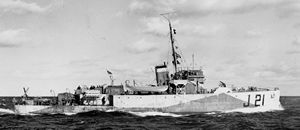 |
|
Catalogue number **** The Ton class, H.M.S. Soberton, M1200 The next vast class of minesweepers was the Ton class of the 1950s. The fear of an enemy mining the entrance to British ports and coastal waters plus the technological advances in both types of mine and methods to sweep them. Between 1953 and 1958, 116 Ton class minesweepers were commissioned, double mahogany hull on alluminium alloy frame and other fittings to give a low magnetic profile. The Ton class was equiped to sweep contact and influence mines, both magnetic and acoustic types. The Ton class shown here has both large and small types of Oropesa float - for sea and coastal sweeping - on the quarterdeck, davits port and starboard for a double sweep, rollers for the LL sweep center of the stern and for the wire sweeps above. The winches for the wire sweep and the LL sweep are under the deckhouse. Note the bicycle between the two davits. 22cm x 19cm Colour print |
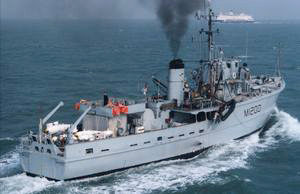 |
|
Catalogue number 05003 Minesweeping gear on a Ton class minesweeper This stern view of a Ton class minesweeper show the minesweeping gear on the quarterdeck of a Ton class: vertical rollers for the wire sweeps and a horizontal roller center stern for the LL sweep, davits for handling the otter boards/kites (of the vane type) and Oropesa floats, mid-ships the wire winch and behind it the winch for the LL sweep. In addition, this ship has two depth charge rails. She is alongside H.M.S. Tarlton, probable at Doig's shipyard, Grimsby in the 1950s. 24.4cm x 19cm Modern silver print |
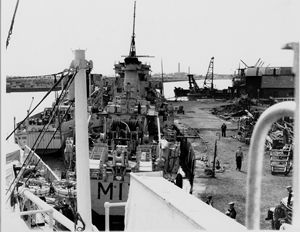 |
|
Catalogue number 86 F1 Ton class minesweeper M1216 with LL sweep out This aerial view of H.M.S. Crofton, commissioned in 1958, shows the LL sweep streamed over the stern, Orpesa wire sweep gear is on the quarterdeck, note the modern, mulit-vaned otter/kite to port. 23.5cm x 24cm Gelatin silver print |
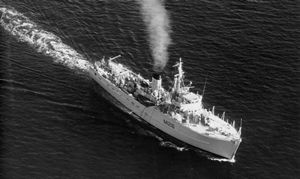 |
|
Catalogue number 142003 U.S.S. Dominant,Agile-class ocean-going minesweeper, pre-1968 Built during the massive American minesweeper construction programme of 1951-1957, wood construction, bronze and stainless steel fittings to reduce the magnetic signature. With a full outfit including a mine-locating sonar, these ships could sweep moored contact, magnetic and acoustic mines, we can see the Oropesa sweeping gear aft with the winches for the wire and LL sweep on the deckhouse roof. 23.5cm x 24cm Gelatin silver print |
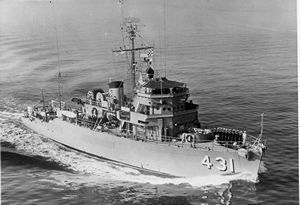 |
|
Catalogue number 90 B.N.S. De Brouwer, M904 Originally a 1954 Agile-class ocean minesweeper, Namsen AM499 went to the Norwegian Navy on construction before being transferred to the Belgian Navy in 1966 where she was converted to a minehunter in 1973. From stern forward, we can see four vanes otter/kite, between the two Zodiacs the acoustic generator, a large Oropesa float below the starboard Zodiac, two PAP104 on the upper deck then the LL sweep winch with shallow water floats fixed to the rail of the deckhouse roof. Recto:"STANAVFORCHAN B.N.S. De Brouwer, Portsmouth England May 1984" 25cm x 19.8cm Colour print |
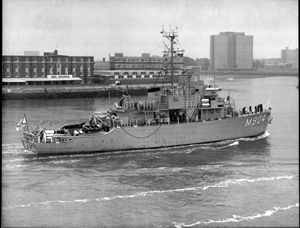 |
|
Catalogue number 142024 Inshore minesweeping The risk of an enemy mining the waters around the adversary's coast has led to the design of minesweepers adapted for working in the shallow waters of rivers, estuaries and coastal shipping channels. The Ham class and the Ley class of inshore minesweepers were built in large numbers from the mid-50s onward as part of NATO programme to counter mines in the event of war notably with the Soviet Union. The ships were of entirely of wood (Ham class) or composite wood/non-ferous metal (Ley class) such as aluminium alloy, giving them a low magnetic signature (to limit the risk of detonating magnetic mines). Both large and lightweight versions of the Oropesa float were carried as well as a lightweight MM11 magnetic loop sweep and acoustic hammer box. Sweeps could be made in as little as 3.7m/12 feet of water, draught being 1.68m/1.75m 5ft 6in/5ft 9in. Packing all this equipment on such small vessels was quite a feat. Note the twin 20mm anti-aircraft gun on the foredeck. 14.9cm x 10.5cm Gelatin silver print |
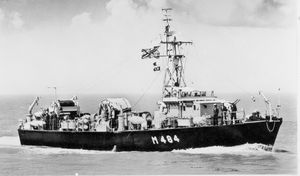 |
|
Catalogue number 142023 Tongeren M475, Belgian Ham class type minesweeper This Belgian minesweeper, commissioned 1958, was one of the 15 Temse class inshore sweepers derived from the Ham class and with the purpose of clearing the Schelde River in the event of mining. We can see a full outfit for sweeping all sorts of mines: from bow to stern, a large paravane, an acoustic array just forward of the LL winch, just aft of this winch are several of the lighter inshore paravanes, just forward of the stern davis in the wire sweep winch with two more paravanes. Note the open bridge with a flimsy canvas cover and several guests on board. 14.8cm x 10.6cm Gelatin silver print |
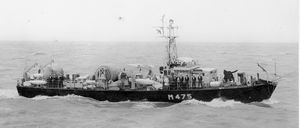 |
|
Catalogue number 70120 Mine Countermeasured vessels (MCM) As sensor technology for influence mines developed, it became necessary to have ships that had not only the capability to detect and sweep contact mines but also detect and neutralise bottom mines that can be detonated by the magnetic field, accoustic signature or pressure wave of a passing ship. Furthermore, these mines do not necessariy go off with the first passage of a ship, they can have delayed activation or require a number of passages before exploding, for example. In addition to minesweeping gear, the mine hunter uses high definition sonar to locate a floating or bottom mine-like object then identify the object using a remotely operated vehicle (ROV). The ROV can drop an explosive charge alongside the mine then retire before detonating the charge. Explosive charges can also be used to cut the wire of floating mines. The ship and its crew stay outside suspected mined waters but because the minehunter operates at low speed it becomes a target for enemy attack so it must have the protection of a warship. Here we have the MCM vessels H.M.S. Brocklesby M33, H.M.S. Ledbury M30, the Dutch minesweeper Hs.Ms. Ommen and the Belgian minehunter B.N.S. Breydel M906. 24.4cm x 19cm Modern print |
|
|
Catalogue number H.M.S. Brocklesby, a glass-fibre MCM vessel Combining high definition sonar, mine clearance divers and the expendable Seafox mine disposal vehicle, this Hunt-class minehunter was one step away from the full unmanned mine clearance principle. There is still a danger to divers and for each detonated mine, the Seafox is lost but it is said to have low maintenance and replacement costs. The German-built Seafox is small, overall length is 1.31m, diameter 20cm body, 39cm across fins and weight 43kg, cost is said to be around 89,000 euros/100,000$ (data from 2012). When one mine is found, there are usually others in the area so mineclearance with Seafox could become a costly affair with the need for an important backup to supply replacement vehicles. Credit: Nick Newns Digital file |
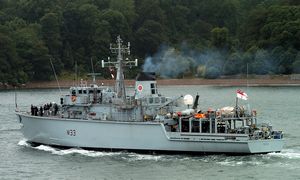 |
|
Catalogue number 142043 French minehunter Croix du Sud, M646 In a similar way that radar impacted the location and ranging on an enemy ship, so the develpment of powerful, high definition, beamed and side-looking sonar enabled the location and ranging on a moored or bottom mine. From a stand-off position, in the early days of minehunting, divers were sent down to identify and destroy mines. Today, an unmanned minehunting/minekilling submersible (or remote operated vehicle, ROV) can go in and neutralise the mine whilst the ship stays at a safe distance. The French Navy's PAP 104 was the first modern device of this kind (The Naval Institute guide to world naval weapons systems, N. Friedman, 1989,page 461). This photograph of the French Navy minehunter Croix du Sud, M646, commissioned 1986, shows two PAP 104 mark 5 ROVs on the quarterdeck. Note the rails for moving the ROV into position and the crane for launch and recovery. Credit: D.C.A.N. Lorient 25.4cm x 17.8cm Colour print |
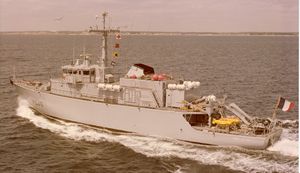 |
|
Catalogue number 142043 Croix du Sud, M646, detail showing PAP 104 ROV. This zoom shows the two PAP 104 mark 5 on their mountings, the white arrow on a red background. There is what looks like a white decompression chamber on the upper deck to starboard, the crew on these ships included six divers. Credit: D.C.A.N. Lorient 25.4cm x 17.8cm Colour print |
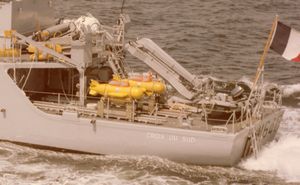 |
|
Catalogue number 73029 French minehunter Pegase, 1985 She appears to be equiped with two PAP 104 mark 5 to port (see white arrow on dark background on ROV), the hydraulic crane deployed over the stern and we can just make out the hook for picking up the PAP 104, note the rails running from the ROV housing to the stern. The white tube-like structure to starboard on the upper deck may be a decompression chamber with the entrance hatch open. Credit: Bar 13.4cm x 8.2cm Gelatin silver print |
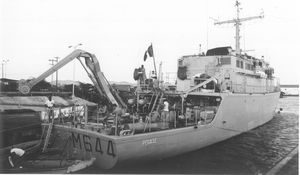 |
|
Catalogue number 36046 French Navy Persee, M649 Persee was one of the thirteen Eridan class/11 type tripartite French minehunters built in cooperation between France, Belgium and the Netherlands. Everything was done to reduce the magnetic signature of these vessels, fibreglass hull, extensive use of non-ferrous metals, propulsion by electric motors when hunting. Credit: DCAN Lorient 23.9cm x 17.8cm Colour print |
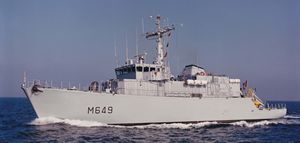 |
|
Catalogue number 35080 German Navy minehunter Tubingen, M1074 Lindau-class German Navy minesweeper, note the open bridge, two sizes of Oropesa float for open sea (just aft of the funnel)and shallow water (by the stern davits) sweeping. Verso: "Minehunter "Marburg" same type as "Volklingen" and "Cuxhaven" in French Credit: Die Bildstelle der Marine, Wilhelmshaven 16.8cm x 12cm Modern print |
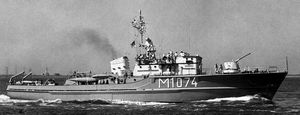 |
|
Catalogue number 70119 German Navy minehunter Tubingen, M1074 Tubingen M1074, commissioned 1958, was converted from a coastal minesweeper to a class 331 minehunter in 1978. In this photograph we can see one PAP104 on the port quarterdeck. Credit: Die Bildstelle der Marine, Wilhelmshaven 23cm x 17.1cm Modern print |
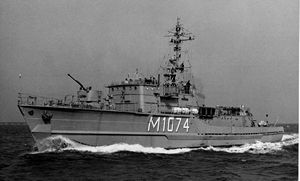 |
|
Catalogue number 123033 Marking the swept channel Dressed over, this newly commissioned Admiralty trawler has an A-frame aft and strake to protect the hull when handling the otter. There are two dan buoys fixed to the foremast shrouds. Attached to a heavy weight on the seabed, Dan buoys were used to mark the cleared channel. Note the unshielded 12pdr gun on the forecastle. 13.7cm x 8.4cm Gelatin silver print |
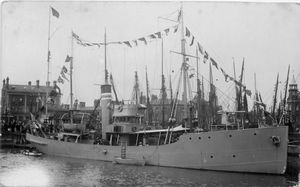 |
|
Catalogue number 01011 Western Isles dan-layer H.M.S. Bryher The gantries forward of the bridge were for lifting the dan buoys. It was quite an art to catch the mooring wire of the buoy whilst the ship was underway, note the stock of buoys on deckhouse roof. Credit: Weight and Logan 13.4cm x 8.3cm Gelatin silver print |
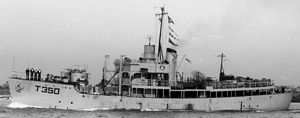 |
|
Catalogue number 134012 A-frame and Oxis davit An improvement on the A-frame for working the otter and sweep wire was the use of a stern davit (Oxis or Quixo patent davit) that could pivot across the deck and over the ship's side. Note strakes on stern to protect against rubbing when dropping and hauling up the otter board. Sherborne has the old A-frame for sweeping. 4.2cm x 3.5cm Negative |
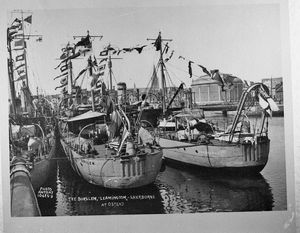 |
|
Catalogue number 138013 H.M.S. Monarch, detail Otter board and A-frame. The otter was very heavy, made of wood and metal, and difficult to handle in a heavy sea. 16.5cm x 11cm Gelatin silver print |
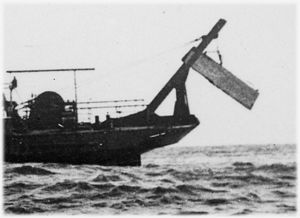 |
|
Catalogue number 96016 H.M.S. Melton, detail Otter board and A-frame 12.7cm x 6.8cm Printed image |
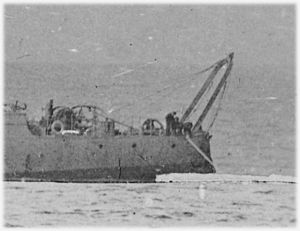 |
|
Catalogue number 135103 Minesweepers gathered in the harbour of Lervik, Norway, 1919 All with A-frames, inshore minesweeping Ex-American/Canadian Elco-built motor launch ML297, Hunt class minesweepers (thin funnel), Aberdare minesweepers (broad funnel, steam pipes fore and aft of funnel) accompanied by the Admiralty steel drifter Flicker and second drifter right background. Ships dressed over. Verso: Text in English from brother to sister, postcard franked in Dorchester 1919 Recto:"English minesweepers on the Lervik harbor, Norway" in English and in Norwegian 13.6cm x 8.5cm Matt gelatin silver print |
|
|
Catalogue number Scheme of Oropesa sweep The wire sweep is held out away from the ship in a lateral curve by the otter board whereas the kite pulls the sweep down over the stern fairlead to a determined depth, now both otter and kite have several sloping vanes held in the otter/kite frame |
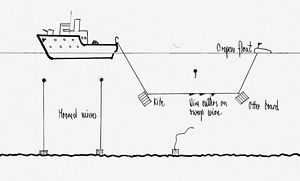 |
|
Catalogue number 112089 Oropesa float with position flag The float is outboard and , as the sweep wire is paid out, the float will be pulled away from the ship by the otter until the required length has gone out and the kite then goes overboard. The arc of the sweep can be followed by the flag on the float. 7.6cm x 11 cm Gelatin silver print |
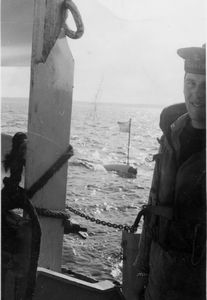 |
|
Catalogue number 122063 Royal Navy paravane Defintion of a paravane "anti-moored-mine device towed from forefoot, usually one on each bow, with hydrostatic depth-keeping and cutter for use against mine mooring-wire", from Jane's Dictionary of Naval Terms, compiled J. Palmer, 1975, Macdonald and Jane's Ltd. WW1 silent film of handling a paravane 13cm x 8cm Gelatin silver print |
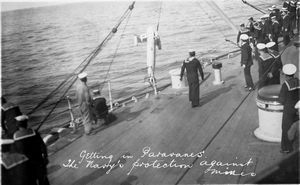 |
